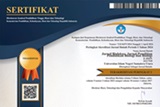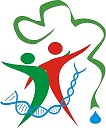Potential of biological agents (Pseudomonas sp.) in plastic waste biodegradation process
Abstract
Keywords
Full Text:
PDFReferences
Anwar, B. (2008). Biodegradasi poli (hidroksibutirat co caprolakton) dengan menggunakan lumpur aktif. Jurnal Pengajaran Matematika dan Ilmu Pengetahuan Alam, 12(1), 1–11. https://doi.org/10.18269/jpmipa.v12i1.319
Bhardwaj, H., Gupta, R., & Tiwari, A. (2012). Microbial population associated with plastic degradation. Open Access Scientific Reports, 1(5), 10–13. https://doi.org/10.4172/scientificreports.
Dang, T. C. H., Nguyen, D. T., Thai, H., Nguyen, T. C., Hien Tran, T. T., Le, V. H., … Nguyen, Q. T. (2018). Plastic degradation by thermophilic Bacillus sp. BCBT21 isolated from composting agricultural residual in Vietnam. Advances in Natural Sciences: Nanoscience and Nanotechnology, 9(1), 1–12. https://doi.org/10.1088/2043-6254/aaabaf
Dewi, A. P., & Yesti, Y. (2018). Pemanfaatan Limbah Plastik Menjadi Kemasan Ramah Lingkungan Serta Uji Biodegradasinya. JOPS (Journal Of Pharmacy and Science), 1(2), 33–38. https://doi.org/10.36341/jops.v1i2.492
Fadlilah, F. R., & Shovitri, M. (2014). Potensi isolat bakteri bacillus dalam mendegradasi plastik dengan metode kolom winogradsky. Jurnal Teknik Pomits, 3(2), 2337–3539.
Hendiarti, N. (2018). Combating Marine Plastic Debris in Indonesia. Coordinating Ministry for Maritime Affairs Republic of Indonesia.
Islami, A. N. (2019, June 30). Biodegradasi plastik oleh mikroorganisme. INA-Rxiv. https://doi.org/10.31227/osf.io/rfkpy
Khoironi, A., Huda, K., Hambyah, I., & Dianratri, I. (2021). Pengaruh mikroplastik polietilen dan oxo-degradable (Oxium) pada pertumbuhan Mikroalga Tetraselmis Chuii. Jurnal Ilmu Lingkungan, 19(2), 211–218. https://doi.org/10.14710/jil.19.2.211-218
Kurnia, D. R. D., Permatasari, I., & Rafika, Y. (2015). Isolasi mikroorganisme anaerob limbah cair tekstil menggunakan desikator sebagai inkubator anaerobik. Fluida, 11(1), 26–33. https://doi.org/10.35313/fluida.v11i1.554
Muhonja, C. N., Makonde, H., Magoma, G., & Imbuga, M. (2018). Biodegradability of polyethylene by bacteria and fungi from Dandora dumpsite Nairobi-Kenya. PLoS ONE, 13(7), 1–17. https://doi.org/10.1371/journal.pone.0198446
Muktiono, E., & Soediantono, D. (2022). Literature Review of ISO 14001 environmental management system benefits and proposed applications in the defense industries. Journal of Industrial Engineering & Management Research, 3(2), 1–12.
Musdary, F., Amalia, L., Maulana, R., Lubis, A., Ningsih, W., & Medan, U. N. (2021). Systematic review : Efektifitas Ideonella sakaiensis dan Chlamydomonas reinhardtii sebagai agen biodegradasi berbahan dasar PET. Jurnal Biolokus : Jurnal Penelitian Pendidikan Biologi Dan Biologi, 4(1), 20–26.
Novia, T. (2021). Pengolahan limbah sampah plastik Polyethylene Terephthlate (PET) menjadi bahan bakar minyak dengan proses pirolisis. Gravitasi : Jurnal Pendidikan Fisika Dan Sains, 4(1), 33–41.
Octavianda, F. T., Asri, M. T., & Lisdiana, L. (2016). Potensi isolat bakteri pendegradasi kenis plastik polietilen oxo-degradable dari tanah TPA benowo surabaya. Lentera Bio: Berkala Ilmiah Biologi, 5(1), 32–35.
Purba, D., Warouw, V., Rompas, R. M., Sumilat, D. A., Kreckhoff, R. L., & Ginting, E. L. (2020). Analisis komunitas bakteri pada sampah plastik. Jurnal IIlmiah Platax, 8(2), 188–195.
Purwaningrum, P. (2016). Upaya mengurangi timbulan sampah plastik di lingkungan. JTI, 8(2), 141–147.
Rahmadian, C. A., Ismail, Abrar, M., Erina, Rastina, & Fahrimal, Y. (2018). Isolasi dan identifikasi bakteri Pseudomonas sp. pada ikan asin di tempat pelelangan ikan Labuan Haji Aceh Selatan. Jimvet, 2(4), 493–502.
Riandi, M. I., Kawuri, R., & Sudirga, S. K. (2017). Potensi bakteri Pseudomonas sp. dan Ochrobactrum sp. yang diisolasi dari berbagai sampel tanah dalam mendegradasi limbah polimer platsik berbahan dasar High Density Polyethylene (HDPE) dan Low Density Polyethylene (HDPE). SIMBIOSIS: Journal of Biological Sciences, 5(2), 58–63. https://doi.org/10.24843/jsimbiosis.2017.v05.i02.p05
Rizqah, Z., Setyaningsih, M., & Mayarni, M. (2019). Hubungan pengetahuan mikrobiologi dengan sikap peduli terhadap kesehatan pada mahasiswa pendidikan biologi. Bioeduscience, 3(1), 7–13. https://doi.org/10.29405/j.bes/317-133162
Rori, C. A., Kandou, F. E. F., & Tangapo, A. M. (2020). Aktivitas enzim ekstraseluler dari bakteri endofit tumbuhan mangrove Avicennia marina. Jurnal Bios Logos, 10(2), 48–56. https://doi.org/10.35799/jbl.11.2.2020.28338
Sari, D. P., Amir, H., & Elvia, R. (2020). Isolasi bakteri dari tanah tempat pembangan akhir (TPA) air sebakul sebagai agen biodegradasi limbah plastik polyethylene. Alotrop, 4(2), 98–106. https://doi.org/10.33369/atp.v4i2.13833
Sendjaya, D. A., Kardila, I. R., Lestari, S., & Kusumawaty, D. (2021). Review: Potensi bakteri dari saluran pencernaan ikan sidat (Anguilla sp.) sebagai pendegradasi sampah plastik. Jurnal Indobiosains, 3(2), 18–27. https://doi.org/10.31851/indobiosains.v3i2.5848
Setyati, W. A., & Subagiyo. (2012). Isolasi dan seleksi bakteri penghasil enzim ekstraseluler (proteolitik, amilolitik, lipolitik dan selulolitik) yang berasal dari sedimen kawasan mangrove. Jurnal Ilmu Kelautan, 17(3), 164–168.
Shah, A., & Alshehrei, F. (2017). Biodegradation of synthetic and natural plastic by microorganisms. Journal of Applied & Environmental Microbiology, 5(1), 8–19. https://doi.org/10.12691/jaem-5-1-2
Sriningsih, A., & Shovitri, M. (2015). Potensi isolat bakteri Pseudomonas sebagai pendegradasi plastik. Jurnal Sains Dan Seni ITS, 4(2), 67–70.
Sukarman, Dewadi, F. M., Supriyanto, A., Sumandar, & Karyadi. (2021). Pengaruh penahanan suhu reaktor pada pengujian LDPE dengan debit air 46 L/Min. Jurnal Mechanical, 2(1), 19–27.
Surono, U. B. (2013). Berbagai metode konversi sampah plastik menjadi bahan bakar minyak. Jurnal Teknik, 3(1), 32–40.
Tokiwa, Y., Calabia, B. P., Ugwu, C. U., & Aiba, S. (2009). Biodegradability of plastics. International Journal of Molecular Sciences, 10(9), 3722–3742. https://doi.org/10.3390/ijms10093722
Wahyudin, Y., & Rahayu, D. N. (2020). Analisis metode pengembangan sistem informasi berbasis website: A literatur review. Jurnal Interkom: Jurnal Publikasi Ilmiah Bidang Teknologi Informasi Dan Komunikasi, 15(3), 26–40. https://doi.org/10.35969/interkom.v15i3.74
Warlina, L. (2019). Pengelolaan sampah plastik untuk mitigasi bencana lingkungan. Journal of Chemical Information and Modeling, 53(9), 89–108.
DOI: http://dx.doi.org/10.30821/biolokus.v5i2.1192
Refbacks
- There are currently no refbacks.
Copyright (c) 2023 Jurnal Biolokus: Jurnal Penelitian Pendidikan Biologi dan Biologi
indexed by :












